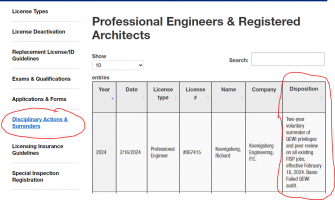Is QEWI just the city inspections? And he can still practice engineering?
A QEWI is a city-mandated periodic inspection of an existing facade conducted by a private 3rd party.
Key clarification: this QEWI engineer did not design the building, and is not the engineer of record for the building.
At question here is his ability to evaluate every 5 years the structural stability of existing facades that were designed by other people, looking for the potential of elements to fall off and injure people below.
So in this settlement, they are focused on his 3rd party forensic inspection abilities; they are not (yet) questioning his legal permission or abilities to engineer new buildings, or to inspect them.
See
https://fontanarchitecture.com/what-is-a-qewi-nyc-fisp/
Excerpts:
***
In New York City, buildings over six stories must be inspected once every five years to ensure the public’s safety. An architect or engineer authorized to perform this inspection type is called a QEWI.
What is a QEWI?
A Qualified Exterior Wall Inspector or QEWI is a qualification that a Registered Architect or Professional Engineer can obtain through the Department of Buildings to perform exterior wall inspections for the NYC Façade Inspection & Safety Program (FISP), previously known as Local Law 11.
FISP
The Façade Inspection & Safety Program requires all buildings over six stories to have an inspection performed of the building façades. These inspections are performed by private companies such as Architecture and Engineering firms.
FISP exists to ensure the public’s safety and protect people from potentially falling debris. The goal is to look for deficiencies and unsafe conditions, or conditions that could one day become unsafe, and repair them promptly. FISP comes from
Local Law 11 of 1998.
Qualified Exterior Wall Inspector
To become a QEWI or Qualified Exterior Wall Inspector, one must first have a Registered Architect or Professional Engineer license in the State of New York. If the architect or engineer has the appropriate experience, the NYC Department of Buildings (DOB) will give them the qualification of a QEWI.
A QEWI is the only person who can perform FISP inspections, and only a QEWI can submit a FISP report to the Department of Buildings. The QEWI has an account with the DOB to submit the reports.
FISP Report
The QEWI will identify the building in one of three categories.
- Safe
- SWARP Safe With Maintenance and Repair Program
- Unsafe
If the building is Safe, there is nothing to do until the next cycle. FISP cycles are five years. Every building must be inspected every five years, even if it was safe in the previous cycle.
If the building is SWARP or Unsafe, then repairs must be performed. An architect or engineer will prepare drawings and details of the repair work. These are filed with the DOB to obtain permits. Upon completion of all the repairs, the QEWI will submit an amended report changing the status of the building.
QEWI’s in New York
The QEWI is essential in maintaining the public’s safety in New York City. The DOB regularly issues fines and violations to buildings for noncompliance. Building owners should always take building safety seriously.

